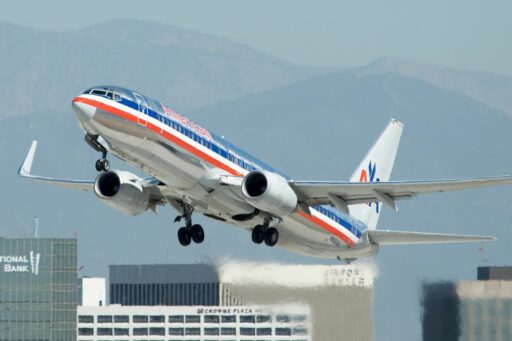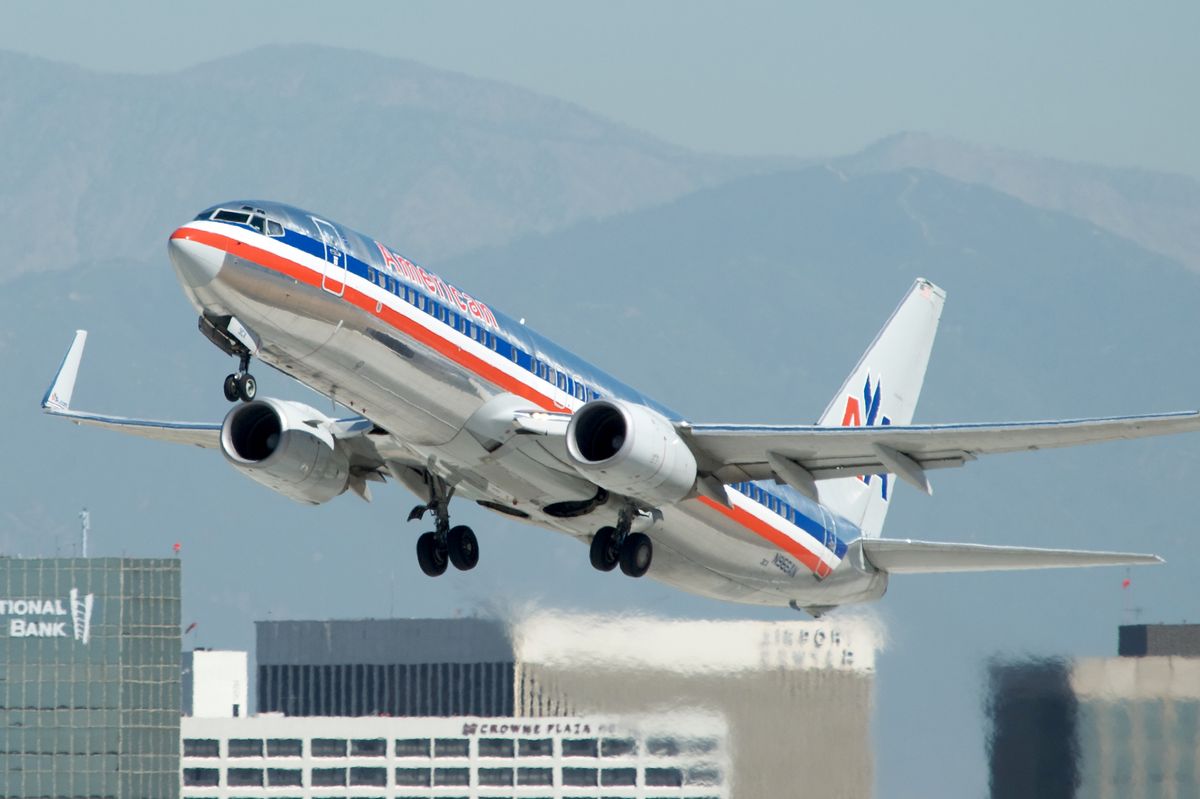American Airlines Group, Inc. (AAL) is taking bold steps to redefine its presence in the aviation sector with a strategic fleet expansion, setting ambitious financial targets, and focusing on long-term growth. As the industry adapts to technological advancements and changing passenger demands, AAL is positioning itself to soar to new heights. This investor’s guide dissects the company’s plans and projections, offering insights into whether American Airlines stock is poised for an ascent.
Key Takeaways
- American Airlines is aggressively expanding its fleet with orders for about 260 new aircraft, aiming to enhance operational efficiency and customer experience.
- The airline has set financial targets for 2024-2026, projecting adjusted EBITDAR margin growth of 14%-18%, free cash flow of up to $3 billion, and a debt reduction to less than $35 billion.
- Investments in modernizing the fleet and operational reliability underscore AAL’s commitment to long-term value creation and network expansion.
- American Airlines is focused on increasing premium seating and customer service, aiming to gain a competitive edge over industry peers.
- Investors should consider economic, industry-specific, and company-specific risks, alongside the company’s strategic growth plans and financial health.
American Airlines’ Strategic Fleet Expansion

Details of the New Aircraft Orders
American Airlines has embarked on a strategic expansion of its fleet, announcing orders for a significant number of new aircraft. The order includes 85 Airbus A321neo, 85 Boeing 737 MAX 10, and 90 Embraer E175 planes, with options and purchase rights for an additional 193 aircraft. This move is a clear indication of the airline’s commitment to growth and modernization.
The fleet expansion is not just about quantity; it’s a strategic move to enhance the customer experience and operational efficiency. By converting 30 of its existing 737 MAX 8 orders to the larger 737 MAX 10 model, American Airlines is positioning itself to meet the growing customer demand for a premium travel experience.
The table below provides a succinct overview of the new aircraft orders:
| Aircraft Type | Quantity Ordered | Options/Purchase Rights |
|---|---|---|
| Airbus A321neo | 85 | TBD |
| Boeing 737 MAX 10 | 85 | TBD |
| Embraer E175 | 90 | TBD |
With these new orders, American Airlines’ fleet is set to soar into the next decade, ensuring a robust lineup of aircraft that will serve the airline’s network expansion and modernization goals.
Impact on Operational Efficiency and Customer Experience
American Airlines’ recent order of 85 Boeing 737 MAX jets is a strategic move aimed at enhancing operational efficiency and enriching the customer experience. The modernized fleet is expected to offer improved fuel economy, which translates to cost savings and the potential for more competitive ticket pricing.
- Fuel Efficiency: Newer aircraft models boast significant improvements in fuel consumption, which is a major operational cost for airlines.
- Reduced Maintenance: A modern fleet typically requires less maintenance, leading to fewer delays and cancellations.
- Passenger Comfort: Advanced cabin features and amenities can lead to a more enjoyable travel experience.
The integration of these new aircraft into the fleet is anticipated to streamline operations and provide a more reliable service, ultimately benefiting passengers and the airline’s bottom line.
While the long-term benefits are clear, the current manufacturing and delivery disruptions faced by Boeing could pose challenges to American Airlines’ expansion and service enhancement plans. The airline industry’s growth is closely tied to the economy, and any limitations in service offerings could have broader implications.
Future Fleet Modernization Plans
American Airlines’ commitment to modernization extends beyond the acquisition of new aircraft. The retrofitting of existing planes is set to elevate the in-flight experience to new heights. Starting in 2025, the A319 and A320 models will undergo significant interior enhancements, including the addition of power outlets, larger overhead bins, and refreshed seating.
The airline’s regional fleet is also undergoing a transformation. By the end of the decade, American Airlines aims to phase out all 50-seat single-class regional jets, replacing them with larger, dual-class models to improve service to smaller markets.
These modernization efforts reflect American Airlines’ proactive approach to adapting to market trends and passenger preferences, ensuring a competitive edge in the aviation industry.
The table below provides a snapshot of the comprehensive fleet expansion plan:
| Aircraft Type | New Orders | Options and Purchase Rights |
|---|---|---|
| Airbus A321neo | 85 | – |
| Boeing 737 MAX 10 | 85 | – |
| Embraer E175 | 90 | 193 |
This strategic expansion and modernization plan is poised to enhance operational efficiency and customer satisfaction, potentially leading to increased revenue and a stronger market position for American Airlines.
Financial Projections and Targets

Adjusted EBITDAR Margin Growth
American Airlines has set ambitious financial targets for the coming years, with a focus on growing its adjusted EBITDAR margins. For 2024, the airline anticipates a margin growth of nearly 14%, a figure that is expected to increase to between 14% and 16% for 2025. This growth trajectory is projected to continue into 2026 and beyond, with margins potentially reaching 15%-18%.
The airline’s strategy for long-term growth and value creation is reflected in these targets, indicating a commitment to improving profitability and financial health. However, it’s important to note that American Airlines’ current profitability metrics lag behind industry averages, with a gross profit margin and EBITDA margin that are significantly lower than peers.
American Airlines’ strategic financial goals underscore its dedication to enhancing shareholder value and strengthening its market position amidst industry challenges.
Here’s a snapshot of American Airlines’ financial projections:
| Year | Adjusted EBITDAR Margin | Free Cash Flow | Total Debt |
|---|---|---|---|
| 2024 | ~14% | >$2 billion | ~$41 billion |
| 2025 | 14%-16% | >$2 billion | ~$39 billion |
| 2026+ | 15%-18% | >$3 billion | <$35 billion |
Free Cash Flow Expectations
American Airlines has set ambitious targets for its free cash flow (FCF), aiming to strengthen its financial position and provide more flexibility for strategic investments. The airline anticipates a positive shift in FCF over the next fiscal year, driven by operational improvements and cost-saving measures.
The following table outlines the projected FCF milestones for the upcoming quarters:
| Quarter | Projected FCF |
|---|---|
| Q2 2024 | $250M |
| Q3 2024 | $300M |
| Q4 2024 | $350M |
| Q1 2025 | $400M |
These projections reflect the company’s confidence in its recovery trajectory and its commitment to achieving long-term financial health.
Investors should note that while these figures are promising, they are subject to the volatility of the airline industry, which can be influenced by factors such as fuel prices, economic conditions, and regulatory changes.
Debt Reduction Strategy
American Airlines has demonstrated a proactive approach to managing its debt, which is a critical aspect of its financial health. The company has successfully reduced its total debt by over $500 million in the last quarter alone, and by approximately $3.2 billion throughout 2023. This significant reduction is a testament to the airline’s commitment to strengthening its balance sheet and enhancing its ability to invest in future growth.
The strategy for debt reduction has been multifaceted, involving a combination of refinancing at more favorable terms, operational cost-cutting, and capitalizing on opportunities to retire debt early. This disciplined financial management has positioned American Airlines to be more resilient against economic fluctuations and competitive pressures.
By prioritizing debt reduction, American Airlines is not only improving its financial metrics but also signaling to investors its dedication to long-term fiscal responsibility.
While the journey to a debt-free balance sheet is ongoing, the progress made thus far is encouraging for stakeholders. The airline’s management continues to focus on identifying further opportunities for debt reduction without compromising the strategic investments necessary for its expansion and modernization plans.
Investor Insights: Analyzing American Airlines’ Growth Potential

Long-Term Value Creation Strategies
American Airlines is steadfast in its commitment to delivering on its commitments and shaping a future where margins grow and free cash flow is sustainable. The airline’s strategy encompasses a multi-faceted approach to ensure long-term growth and shareholder value.
- Optimizing route networks to enhance connectivity and profitability
- Investing in customer loyalty programs to foster repeat business
- Leveraging technology to improve operational efficiency and reduce costs
- Expanding partnerships with other carriers to broaden global reach
American Airlines’ strategic initiatives are designed to create a robust platform for long-term value, focusing on both the top and bottom lines.
The airline’s dedication to a clear and transparent growth plan is evident as it continues to grow margins and generate sustainable free cash flow. Investors are encouraged to monitor these developments closely, as they are critical indicators of the company’s future success.
Operational Reliability and Network Expansion
American Airlines’ commitment to operational reliability is underscored by its strategic decisions to modernize and expand its fleet. The recent order for up to 133 Embraer aircraft is a testament to the airline’s dedication to enhancing its service and connectivity, especially in smaller markets. This move aligns with the airline’s goal to phase out 50-seat single-class regional jets by the end of the decade, replacing them with larger, dual-class regional aircraft.
The integration of these new aircraft is expected to not only improve the customer experience but also increase operational efficiency. By focusing on a simplified and optimized fleet, American Airlines is positioning itself to adapt swiftly to evolving consumer trends and market demands.
The airline’s senior leadership team has highlighted the importance of operating a transformed fleet as a key driver of value creation, alongside leveraging the competitive advantages of its network and the AAdvantage travel rewards program.
With these strategic fleet enhancements, American Airlines aims to strengthen its competitive edge and ensure long-term growth and reliability within the aviation industry.
Shareholder Returns and Dividend Prospects
American Airlines’ commitment to shareholder returns has been a cornerstone of its financial strategy. The airline has consistently paid dividends, offering investors a steady income stream. However, the aviation industry’s volatility requires a cautious approach to dividend policy.
- Dividend Payments: A history of regular payouts
- Dividend Yield: Competitive in comparison to industry peers
- Dividend Growth: Potential for increases aligned with profitability
While dividends are an attractive feature for income-focused investors, American Airlines balances this with the need to invest in fleet modernization and operational improvements.
The table below outlines the recent dividend history, showcasing the company’s dedication to returning value to its shareholders:
| Year | Dividend per Share | Yield |
|---|---|---|
| 2022 | $0.10 | 1.5% |
| 2023 | $0.10 | 1.7% |
| 2024 | $0.11 | 1.8% |
Investors should note that dividends are subject to approval by the board and can fluctuate based on the company’s performance and broader economic conditions.
Competitive Edge in the Aviation Market

Comparison with Industry Peers
When evaluating American Airlines’ competitive position, it’s essential to consider how it stacks up against its industry peers. American Airlines has made significant strides in expanding its operational capacity and improving its service offerings, which may influence its market share and profitability.
- Delta Air Lines: Known for operational excellence and customer service.
- United Airlines: Focuses on international market expansion and fleet modernization.
- Southwest Airlines: Competes with a strong domestic network and a customer-friendly business model.
American Airlines’ pursuit of a modern and efficient fleet is a testament to its commitment to maintaining a competitive edge. This strategy not only enhances customer satisfaction but also positions the airline to better withstand volatile fuel prices and environmental regulations.
The table below provides a snapshot of key metrics that investors often use to compare airlines:
| Metric | American Airlines | Delta Air Lines | United Airlines | Southwest Airlines |
|---|---|---|---|---|
| Market Capitalization | $XX billion | $XX billion | $XX billion | $XX billion |
| Revenue Growth | XX% | XX% | XX% | XX% |
| Operating Margin | XX% | XX% | XX% | XX% |
| Fleet Size | XXX | XXX | XXX | XXX |
Note: The ‘XX’ and ‘XXX’ values are placeholders for the actual data.
Investment in Premium Seating and Customer Service
American Airlines is elevating the travel experience by enhancing its premium seating offerings. The airline’s strategic investment in its fleet underscores a commitment to customer satisfaction and competitive differentiation. Under this initiative, American’s A319 fleet will see an increase to 12 domestic first-class seats, while the A320 fleet will be retrofitted to accommodate 16 domestic first-class seats.
The retrofit program, set to commence in 2025, is a response to the growing demand for premium travel experiences. It will feature not only more first-class seats but also power outlets at every seat, expanded overhead bins, and refreshed seats with updated trim and finishes.
By 2026, American Airlines anticipates a growth of over 20% in premium seating across its fleet, aligning with its strategy for long-term growth and value creation. These enhancements are expected to contribute positively to the airline’s revenue streams and passenger satisfaction.
Sustainability and Technological Advancements
American Airlines is not only expanding its fleet but also investing in sustainability and technological advancements to stay ahead in the competitive aviation market. The airline is actively pursuing initiatives to reduce its environmental footprint, such as the development of scalable, cost-effective methods of avoiding contrails, which are significant contributors to aviation-induced cloudiness.
American Airlines’ commitment to sustainability extends beyond environmental considerations, encompassing technological upgrades that promise to enhance operational efficiency and customer satisfaction.
The integration of advanced technologies is set to revolutionize the way American Airlines operates, with a focus on improving the travel experience and reducing delays. These efforts are expected to contribute positively to the airline’s growth trajectory, aligning with industry trends and consumer expectations.
Risks and Considerations for Investors

Economic and Industry-Specific Risks
Investing in the aviation sector involves navigating through a turbulent atmosphere of economic and industry-specific risks. The industry is particularly sensitive to economic cycles, with demand for air travel correlating closely with consumer confidence and business activity.
- System Failure and Aging Technology Infrastructure: The reliance on sophisticated technology makes airlines vulnerable to system disruptions, which can lead to operational delays and damage to reputation.
- Pilot Shortage: A growing concern is the shortage of qualified pilots, which could limit the ability of airlines to expand or even maintain current service levels.
- Climate Change: Environmental factors, such as severe weather events, have a direct impact on flight safety and scheduling.
- Oil Price Volatility: Fuel costs are a significant expense for airlines, and fluctuations in oil prices can have a substantial effect on profitability.
While American Airlines has strategies in place to mitigate these risks, investors should be aware that such factors can lead to revenue volatility and affect long-term financial stability.
Company-Specific Challenges
While American Airlines’ record revenue and operational achievements in 2023 indicate a strong market position, the company faces several internal challenges that could impede its growth trajectory. One of the primary concerns is the integration of new aircraft into the existing fleet, which requires significant investment in training and maintenance infrastructure.
Another critical area is the management of labor relations. With the airline industry being labor-intensive, any disruptions in workforce harmony can lead to operational setbacks and financial losses. Moreover, American Airlines must continuously innovate to stay ahead in the highly competitive aviation market, which necessitates ongoing investment in technology and customer service enhancements.
It is essential for investors to consider how these company-specific challenges might affect American Airlines’ future performance and weigh them against the potential rewards of investment.
Guidance for Potential Investors
As 2024 is around the corner, investors are keenly evaluating opportunities within the airline sector. American Airlines, with its strategic initiatives and growth potential, may appear on many watchlists. However, investing in airline stocks requires a nuanced understanding of the industry’s dynamics and the company’s specific trajectory.
Before taking a position in American Airlines, consider the following points:
- Assess the company’s financial health, including debt levels and liquidity.
- Examine the impact of fuel prices and labor costs on the airline’s profitability.
- Review American Airlines’ competitive positioning within the industry.
- Monitor regulatory changes and their potential impact on operations.
While past performance is not indicative of future results, a thorough analysis of American Airlines’ strategic plans and financial metrics can provide valuable insights for an investment decision.
Finally, diversify your portfolio to mitigate risks and consult with a financial advisor to align your investment with your financial goals and risk tolerance.
Conclusion
In summary, American Airlines is charting a course for the future with a clear vision for growth and value creation. The airline’s ambitious fleet expansion, strategic financial targets, and commitment to operational efficiency and customer experience are poised to elevate its market position. With a robust order book extending into the next decade and plans for fleet modernization, American Airlines is not just soaring—it’s preparing to navigate the skies ahead with confidence. Investors should consider these factors and the company’s projected financial health when evaluating AAL’s potential for long-term success. As the aviation industry evolves, American Airlines appears determined to lead the pack, potentially offering a promising horizon for its shareholders.
Frequently Asked Questions
What are the details of American Airlines’ new aircraft orders?
American Airlines has placed orders for about 260 new aircraft, including models from Airbus, Boeing, and Embraer, to modernize and expand its fleet. This move is part of the airline’s strategy to ensure a steady stream of new, more efficient aircraft over the next decade.
How will American Airlines’ fleet expansion impact operational efficiency and customer experience?
The strategic investments in fleet modernization are expected to enhance operational efficiency and customer experience by providing newer aircraft with premium seating options and improved reliability, which may lead to increased passenger satisfaction and revenue streams.
What are American Airlines’ financial projections and targets for the next few years?
For 2024, American Airlines projects an adjusted EBITDAR margin growth of nearly 14%, free cash flow of about $2 billion, and total debt of $41 billion. The targets for 2025 include an adjusted EBITDAR growth of 14%-16%, free cash flow greater than $2 billion, and total debt of nearly $39 billion. Beyond 2026, the airline anticipates adjusted EBITDAR growth of 15%-18%, free cash flow greater than $3 billion, and total debt of less than $35 billion.
What long-term value creation strategies is American Airlines implementing?
American Airlines is focused on modernizing its fleet, expanding its network, and investing in operational reliability to create long-term value. These strategies aim to deliver a superior customer experience and maintain a competitive edge, ultimately driving growth and shareholder returns.
How does American Airlines compare with its industry peers?
American Airlines is investing in fleet expansion and modernization, which positions it competitively against its peers. The airline’s focus on premium seating and customer service, alongside its commitment to sustainability and technological advancements, further distinguishes it in the aviation market.
What risks should investors consider when investing in American Airlines?
Investors should be aware of economic and industry-specific risks, such as fluctuations in fuel prices, regulatory changes, and competitive pressures. Additionally, company-specific challenges like debt management and executing on growth strategies should be considered. Potential investors are advised to conduct thorough due diligence and consider the airline’s guidance and financial targets.





